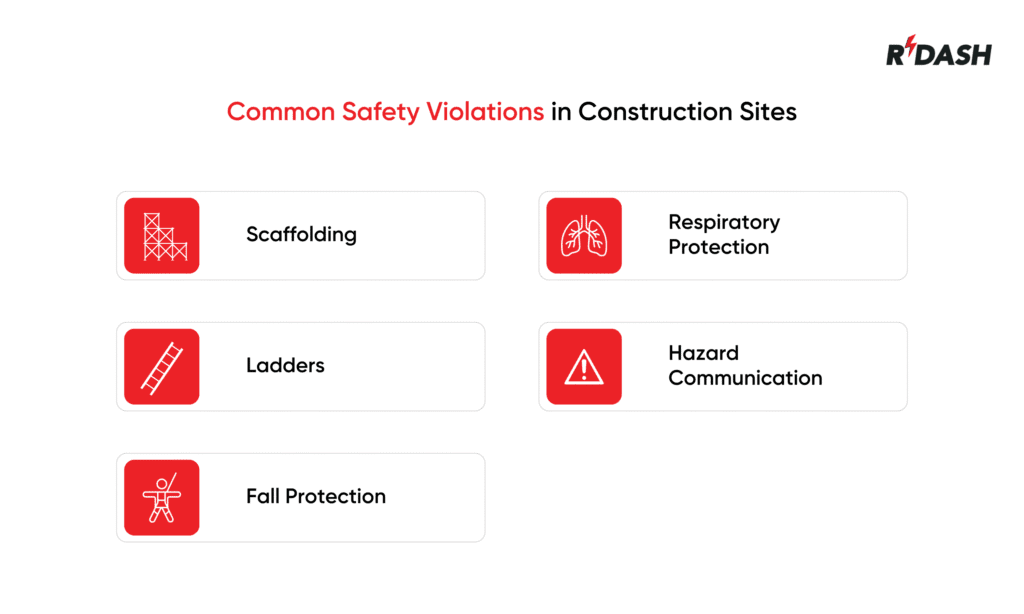Common safety violations in construction
Keeping a construction site safe must always be a top priority. Yet, despite having rules and safety gear, some mistakes keep happening again and again. These common safety violations can lead to serious injuries, accidents, or even stop work completely. Understanding what these risks are is the first step to making sites safer for everyone.
Below are some of the top safety violations found on construction sites:

Scaffolding
Scaffolding is needed to reach higher areas safely, but it also remains one of the most reported causes of accidents. Issues often come up when scaffolding is not secured to a solid base or when damaged parts are not fixed or replaced. Unsafe scaffolding can collapse, putting workers at risk of falling or getting hurt by falling parts and tools.
Ladders
Ladders may look simple to use, but they can be very risky if they’re not used correctly. Many workers get injured every year because the wrong type of ladder is used for a task, or the ladder is set up on an uneven surface. Using a ladder in the wrong way, like leaning an A-frame ladder against a wall when it should be opened fully, increases the chance of falls and injuries.
Fall Protection
Falls are one of the top causes of serious injuries and deaths on construction sites. This often happens because fall protection measures like guardrails, harnesses, or safety nets are missing, broken, or not used properly. Even a small slip at height can have life-changing results, so this remains one of the most important areas to pay attention to on every project.
Respiratory Protection
Construction work can create harmful dust, fumes, and other particles that are dangerous to breathe in. Without the right masks or respiratory gear, workers can face long-term health problems, including lung diseases. Failing to provide or use proper protective equipment puts teams at risk when dealing with dust, chemicals, or any work that releases harmful particles into the air.
Hazard Communication
Chemical products, paints, or other dangerous materials are often used on construction sites. One big mistake is when these items are not clearly labeled or when safety data sheets are outdated or missing altogether. Workers may handle chemicals without knowing the right precautions to take, leading to spills, burns, or other health hazards.
These common safety issues: scaffolding, ladders, fall protection, respiratory protection, and hazard communication – show how easy it can be for things to go wrong if teams are not careful. Every site is different, but the goal is the same: keep people safe, prevent delays, and complete projects without injuries.
How to prevent these common safety violations
Knowing about the most common safety problems on construction sites is one thing — but preventing them takes daily effort and the right steps. Here’s how you can reduce the risks and keep your team safe on every job.
Scaffolding Safety
- Always have scaffolding set up by trained workers who follow the right guidelines.
- Make sure scaffolds are properly anchored to a strong base, like a mudsill, to keep them stable.
- Always inspect scaffolding before use and fix or replace any damaged parts right away.
- Install guardrails and mid-rails to stop falls from open sides.
Ladder Safety
- Choose the right ladder for every job to avoid accidents. Remember, not every ladder works for every job.
- Place ladders on level ground and secure them to prevent slipping.
- Inspect ladders for cracks or loose parts before use.
- Train your crew on proper ladder setup and how to use ladders safely for specific tasks.
Fall Protection
- Make fall protection planning part of daily pre-work meetings.
- Put up guardrails, safety nets, or use personal fall protection systems where required.
- Provide workers with properly fitting harnesses and ensure they know how to use them.
- Regularly check and maintain fall protection equipment to make sure it works when needed.
Respiratory Protection
- Identify tasks that create dust, fumes, or other airborne hazards ahead of time.
- Supply the right protective masks or respirators for each type of work.
- Train workers to check for damage or poor fit on their masks before every use.
- Use methods like spraying water (“wet methods”) to keep dust down when cutting or drilling.
Hazard Communication
- Label all chemicals and hazardous materials clearly.
- Keep material safety data sheets (MSDS) updated and easy for workers to find.
- Teach workers the proper ways to handle, store, and get rid of chemicals.
- Review hazard communication rules regularly so everyone knows what to do.
Putting these safety steps into daily practice helps keep every project site safer. It lowers the risk of injuries, protects your team’s health, and keeps your projects running smoothly without costly delays.
FAQs
Why do safety violations happen so often on construction sites?
Safety violations often happen because of poor planning, lack of training, damaged equipment, or workers not following safety rules. Busy schedules and tight deadlines can also lead to people taking shortcuts.
What’s the best way to keep scaffolding safe?
Always have trained workers set up scaffolding properly. Anchor it to a stable base, check it daily for damage, and install guardrails and mid-rails to prevent falls.
How can I make sure workers use ladders safely?
Provide the right ladder for each job, make sure it’s placed on even ground, and train workers on how to set up and use ladders correctly. Inspect ladders regularly and replace any that are damaged.
What is the most common fall protection mistake?
A common mistake is not using fall protection equipment at all or using it incorrectly. Always plan for fall hazards, provide proper gear, and train workers on how to use it.
How can we avoid respiratory hazards on-site?
Use protective masks or respirators when needed, train workers to inspect and wear them properly, and use “wet methods” to control dust during cutting or drilling.
Why is hazard communication important?
Good hazard communication makes sure everyone knows what chemicals they’re working with, what the risks are, and how to handle them safely. Clear labels and up-to-date safety sheets help prevent accidents.






